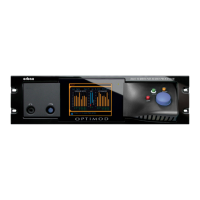OPTIMOD SURROUND PROCESSOR TROUBLESHOOTING
5-5
and/or look-ahead peak limiters. Watch the gain reduction meters and do not let
them go to full scale. You can turn down the gain reduction in the multiband
compressors via the MB
DRIVE (five-band) and 2-BAND DRIVE (two-band) controls.
The normal gain reduction in the look-ahead limiters should not exceed 6 dB.
Advancing the MB
LIMIT DRIVE control too far will cause distortion by creating
large amounts of gain reduction in the look-ahead limiters. Setting D
IALNORM to
high levels will do the same thing. We do not recommend using D
IALNORM values
higher (i.e., closer to 0) than –18 dBfs unless you are specifically trying to make
“loud” masters in mastering applications. (We strongly discourage that because
decades of broadcast experience has shown that over-processing audio cause
subliminal listening fatigue and audience tune-outs.) D
IALNORM values of –25 dB
and below are preferred because these will cause very little gain reduction in the
look-ahead limiters.
• If you are using an external processor ahead of the 8685, be sure it is not clipping
or otherwise causing problems.
Audible noise
(See also “RFI, Hums, Clicks, or Buzzes” on page 5-1.)
• Excessive compression will always exaggerate noise in the source material. The
8685 has two systems that fight this problem. The silence gates freeze the gain
of the AGC and compressor systems whenever the input noise drops below a
level set by the threshold control for the processing section in question, prevent-
ing noise below this level from being further increased.
• There are two independent silence gates in each processing channel of the 8685.
The first affects the AGC and the second affects the Multiband Compressor. Each
has its own threshold control. (See M
B GATE on page 3-57.)
• In sound for picture, the setting of the G
ATE THRESHOLD control is quite critical if
you want the processing to be undetectable to the audience. If this control is set
too low, then the 8685 will pump up quiet sounds like ambiance and underscor-
ing to unnaturally high levels. Refer to Section 3 of this manual for a further dis-
cussion.
• In the Five-Band Structure, dynamic single-ended noise reduction (see D
WNEXP
THR on page 3-59) can be used to reduce the level of the noise below the level at
which it appears at the input.
The 8685's AES3id inputs are capable of receiving words of up to 24 bits.
A 24-bit word has a dynamic range of approximately 144 dB. The 8685's
digital input will thus never limit the unit's noise performance even with
very high amounts of compression.
• See Routing Audio to and from the 8685 starting on page 1-12 for a discussion of
pitfalls that can compromise audio quality.

